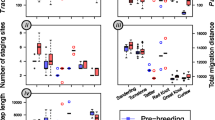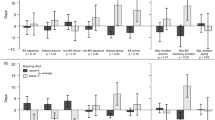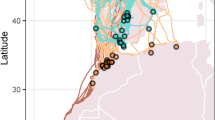Abstract
Migrating birds have to incorporate migration into their annual cycle, next to breeding and moult. This presents the challenge to arrive at the right place at the right time at any given moment during the year to maximize fitness. Although many studies have investigated the timing of specific (life-history) activities of migrating birds, it is poorly studied how the timing and duration of these activities depend on each other and, ultimately, how they affect fitness. Therefore, we investigated variability and dependencies in the timing and duration of successive activities throughout the annual cycle and assessed their fitness consequences in hoopoes (Upupa epops), a long-distance migratory bird, using geolocator and breeding phenology data of five consecutive years. We found that the timing and duration of seasonal activities generally depended on the timing and duration of the preceding activity; yet, the strength of these dependencies and the degree of variability varied between activities. The strongest dependencies were found between the end of breeding and departure from the breeding grounds as well as between the arrival in the breeding grounds and the onset of breeding. We also found fitness consequences of timing and duration but only for specific activities: spring migration and particularly the duration of the pre-breeding period influenced the quality of the territory acquired as well as the total number of fledglings. Consequently, we suggest that our study species has the flexibility to adjust the timing and duration of activities but to varying degrees. This is a step forward in understanding the time-constraints that migratory animals face and in identifying their fitness consequences.
Significance statement
To date, few studies have investigated the timing and dependencies of seasonal activities in migrating birds throughout the annual cycle and their fitness consequences. However, understanding temporal constraints and identifying sensitive—fitness-relevant—periods within the annual cycle is crucial to understand the population dynamics of migrating species. We investigated the timing and duration of life-history activities in a long-distance migratory bird and assessed their fitness consequences. Our results clearly show that seasonal activities were generally linked to the previous activities but that this dependency ceased relative to activities further in the past. We also found clear fitness consequences but only for the timing and duration of specific activities. Thus, our study shows that migrants can adjust the timing and duration of activities to a certain degree but also that this flexibility is more constrained for specific activities.




Similar content being viewed by others
References
Alerstam T (2011) Optimal bird migration revisited. J Ornithol 152:5–23
Arlettaz R, Schaub M, Fournier J, Reichlin TS (2010) From publications to public actions: when conservation biologists bridge the gap between research and implementation. Bioscience 60:835–842
Arlt D, Olsson P, Fox JW, Low M, Pärt T (2015) Prolonged stopover duration characterises migration strategy and constraints of a long-distance migrant songbird. Anim Migr 2:47–62
Bächler E, Hahn S, Schaub M, Arlettaz R, Jenni L, Fox JW, Afanasyev V, Liechti F (2010) Year-round tracking of small trans-Saharan migrants using light-level geolocators. PLoS One 5:e9566
Barta Z, McNamara JM, Houston AI, Weber TP, Hedenström A, Feró O (2008) Optimal moult strategies in migratory birds. Philos T Roy Soc B 363:211–229
Bartlett MS (1937) Properties of sufficiency and statistical tests. Proc R Soc Lond A 160:268–282
Barton K (2016) MuMIn: Multi-Model Inference. R package version 1.15.6. https://cran.r-project.org/web/packages/MuMIn/
Bell AM, Hankison SJ, Laskowski KL (2009) The repeatability of behaviour: a meta-analysis. Anim Behav 77:771–783
Bridge ES, Thorup K, Bowlin MS et al (2011) Technology on the move: recent and forthcoming innovations for tracking migratory birds. Bioscience 61:689–698
Briedis M, Hahn S, Gustafsson L, Henshaw I, Träff J, Král M, Adamík P (2016) Breeding latitude leads to different temporal but not spatial organization of the annual cycle in a long-distance migrant. J Avian Biol 47:743–748
Clausen KK, Madsen J, Tombre IM (2015) Carry-over or compensation? The impact of winter harshness and post-winter body condition on spring-fattening in a migratory goose species. PLoS One 10:e0132312
Fransson T (1995) Timing and speed of migration in north and west European populations of Sylvia warblers. J Avian Biol 26:39–48
Gienapp P, Bregnballe T (2012) Fitness consequences of timing of migration and breeding in cormorants. PLoS One 7:e46165
Gordo O, Tryjanowski P, Kosicki JZ, Fulín M (2013) Complex phenological changes and their consequences in the breeding success of a migratory bird, the white stork Ciconia ciconia. J Anim Ecol 82:1072–1086
Guillod N, Arlettaz R, Jacot A (2016) Impact of spatial variation of a crucial prey, the molecricket, on hoopoe territory occupancy and reproduction. J Avian Biol 47:697–705
Helm B, Gwinner E, Trost L (2005) Flexible seasonal timing and migratory behavior: results from stonechat breeding programs. Ann N Y Acad Sci 1046:216–227
Hoffmann J, Postma E, Schaub M (2015) Factors influencing double brooding in Eurasian hoopoes Upupa epops. Ibis 157:17–30
Hüppop O, Hüppop K (2003) North Atlantic oscillation and timing of spring migration in birds. Proc R Soc Lond B 270:233–240
Jenni L, Winkler R (1994) Moult and ageing of European passerines. Academic Press, London
Jonzén N, Piacentini D, Andersson A, Montemaggiori A, Stervander M, Rubolini D, Waldenström J, Spina F (2006) The timing of spring migration in trans-Saharan migrants: a comparison between Ottenby, Sweden and Capri, Italy. Ornis Svec 16:27–33
Kokko H (1999) Competition for early arrival birds in migratory birds. J Anim Ecol 68:940–950
Langin KM, Norris DR, Kyser TK, Marra PP, Ratcliffe LM (2006) Capital versus income breeding in a migratory passerine bird: evidence from stable-carbon isotopes. Can J Zool 84:947–953
Lindström Å, Alerstam T, Bahlenberg P, Ekblom R, Fox JW, Råghall J, Klaassen RHG (2016) The migration of the great snipe Gallinago media: intriguing variations on a grand theme. J Avian Biol 47:321–334
Lisovski S, Hahn S (2012) GeoLight—processing and analysing light-based geolocator data in R. Methods Ecol Evol 3:1055–1059
Marra PP, Cohen EB, Loss SR, Rutter JE, Tonra CM (2015) A call for full annual cycle research in animal ecology. Biol Lett 11:20150552
Martín-Vivaldi M, Palomino JJ, Soler M, Soler JJ (1999) Determinants of reproductive success in the hoopoe Upupa epops, a hole-nesting non-passerine bird with asynchronous hatching. Bird Study 46:205–216
McNamara JM, Welham RK, Houston AI (1998) The timing of migration within the context of an annual routine. J Avian Biol 29:416–423
Morrison CA, Baillie SR, Clark JA, Johnston A, Leech DI, Robinson RA (2015) Flexibility in the timing of post-breeding moult in passerines in the UK. Ibis 157:340–350
Oppel S, Powell AN, Dickson DL (2008) Timing and distance of king eider migration and winter movements. Condor 110:296–305
R Core Team (2014) R: a language and environment for statistical computing, version 3.1. R Foundation for Statistical Computing, Vienna www.R-project.org
Schmaljohann H, Meier C, Arlt D et al (2016) Proximate causes of avian protandry differ between subspecies with contrasting migration challenges. Behav Ecol 27:321–331
Senner NR, Hochachka WM, Fox JW, Afanasyev V (2014) An exception to the rule: carry-over effects do not accumulate in a long-distance migratory bird. PLoS One 9:e86588
Stanley CQ, MacPherson M, Fraser KC, McKinnon EA, Stutchbury BJM (2012) Repeat tracking of individual songbirds reveals consistent migration timing but flexibility in route. PLoS One 7:e40688
Sutherland WJ (1998) Evidence for flexibility and constraint in migration systems. J Avian Biol 29:441–446
Tøttrup AP, Rainio K, Coppack T, Lehikoinen E, Rahbek C, Thorup K (2010) Local temperature fine-tunes the timing of spring migration in birds. Integr Comp Biol 50:293–304
Tschumi M, Schaub M, Arlettaz R (2014) Territory occupancy and parental quality as proxies for spatial prioritization of conservation areas. PLoS One 9:e97679
van Wijk RE, Bauer S, Schaub M (2016a) Repeatability of individual migration routes, wintering sites and timing in a long-distance migrant bird. Ecol Evol 6:8679–8685
van Wijk RE, Souchay G, Jenni-Eiermann S, Bauer S, Schaub M (2016b) No detectable effects of lightweight geolocators on a Palaearctic-African long-distance migrant. J Ornithol 157:255–264
Weatherhead PJ (2005) Effects of climate variation on timing of nesting, reproductive success, and offspring sex ratios of red-winged blackbirds. Oecologia 144:168–175
Wingfield JC (2008) Organization of vertebrate annual cycles: implications for control mechanisms. Philos T Roy Soc B 363:425–441
Acknowledgments
We thank the people that assisted during fieldwork, and Lukas Jenni, Felix Liechti, Amber Beerman, Judy Shamoun-Baranes, Kasper Thorup and three anonymous reviewers for helpful and constructive comments on previous versions. This project was supported by the Swiss National Science Foundation (31003A_138354 to MS and SB). The Swiss federal office for environment contributed financial support for the development of the geolocators (UTF-Nr. 254, 332, 363, 400).
Author information
Authors and Affiliations
Corresponding author
Ethics declarations
Conflict of interest
The authors declare that they have no conflict of interest.
Ethical approval
All capture and handling of hoopoes complied with contemporary laws regulating the treatment of animals in Switzerland and was approved by the appropriate management agencies and ethical committees.
Informed consent
Informed consent is not applicable in this study.
Additional information
Communicated by B. Voelkl
Electronic supplementary material
ESM 1
(DOCX 490 kb).
Rights and permissions
About this article
Cite this article
van Wijk, R.E., Schaub, M. & Bauer, S. Dependencies in the timing of activities weaken over the annual cycle in a long-distance migratory bird. Behav Ecol Sociobiol 71, 73 (2017). https://doi.org/10.1007/s00265-017-2305-5
Received:
Revised:
Accepted:
Published:
DOI: https://doi.org/10.1007/s00265-017-2305-5




